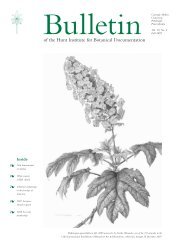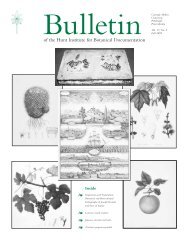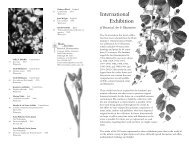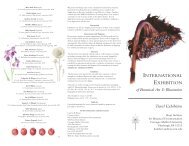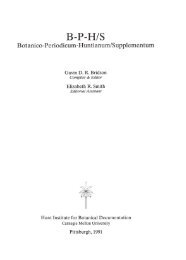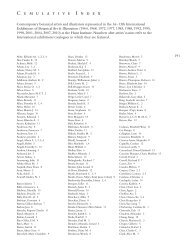Bulletin - Hunt Institute for Botanical Documentation - Carnegie ...
Bulletin - Hunt Institute for Botanical Documentation - Carnegie ...
Bulletin - Hunt Institute for Botanical Documentation - Carnegie ...
Create successful ePaper yourself
Turn your PDF publications into a flip-book with our unique Google optimized e-Paper software.
Anne-Marie Evans lecture and class<br />
During the 10th International festivities Anne-Marie Evans<br />
honored <strong>Carnegie</strong> Mellon University and Chatham College<br />
by presenting a lecture and class on botanical art. Evans<br />
has been the course director in botanical painting <strong>for</strong> the<br />
Diploma Course at Chelsea Physic Garden since it began<br />
and the director of the Old Manor House Studio, which<br />
offers summer courses in her studio in the U.K. She has<br />
conducted courses and master classes at various institutions in<br />
the U.K. (Victoria & Albert Museum, West Surrey College<br />
of Art, etc.), the U.S. (New York <strong>Botanical</strong> Garden, Dallas<br />
Arboretum, Denver Botanic Garden, L.A. Arboretum, etc.),<br />
Australia (<strong>Botanical</strong> Art School of Melbourne), and South<br />
Africa (Kirstenbosch <strong>Botanical</strong> Gardens). She is the founder<br />
president of the Leistershire Society of <strong>Botanical</strong> Illustration,<br />
honorary president of the Chelsea Physic Garden Florilegium<br />
Society, honorary director of the Society of <strong>Botanical</strong> Artists<br />
(SBA), advisor to the Filoli Florilegium Society, honorary<br />
member of the Brooklyn Florilegium Society, and founder<br />
of the project to prepare a florilegium <strong>for</strong> Highgrove <strong>for</strong> the<br />
Prince’s Foundation.<br />
On Saturday 27 October at Chatham College, Anne-Marie<br />
Evans gave a lecture on “Evaluating <strong>Botanical</strong> Art” as part<br />
of the symposium Chatham Green: The Art of the Garden.<br />
Evans thought that it was an appropriate subject given the<br />
number of ASBA members in attendance. As an instructor<br />
of botanical painting, Evans is often called upon to make a<br />
fair assessment of botanical art in her classes and as a juror <strong>for</strong><br />
exhibitions. She began by showing slides comparing plant<br />
material portrayed in botanical art and in fine art painting.<br />
<strong>Botanical</strong> art relies on scientific accuracy and precision so that<br />
the subject can be identified by genus and species, whereas<br />
a fine art painting does not rely on specific in<strong>for</strong>mation and<br />
may even use distortion as an effective means to express an<br />
idea or mood. Evans agrees with Wilfrid Blunt in The Art of<br />
<strong>Botanical</strong> Illustration (New York, 1994) that an artwork should<br />
display scientific accuracy, an aesthetic quality, and technical<br />
skill.<br />
Evans suggested these questions when evaluating a botanical<br />
artwork.<br />
1. Scientific botanical content<br />
Does the artist have the ability to see, understand and<br />
describe the subject? Has the artist studied the original<br />
plant and made minute observations? Is the in<strong>for</strong>mation<br />
significant to identification present? Are the different<br />
surfaces described graphically?<br />
2. Aesthetic content<br />
Is there a deliberation in positioning the subject within<br />
the composition? Is the artist directing your eye into the<br />
picture? Are light and dark masses used to create balance<br />
and contrast? Is there a physical presence to the plant?<br />
3. Technical skill<br />
Are textures, gradation of tones and modeling used to<br />
create a 3-dimensional quality? Is there a quality and a<br />
4 Bull. <strong>Hunt</strong> Inst. Bot. Doc. 13(2), Fall 2001<br />
Anne-Marie Evans evaluating student work. Photos by James J. White.<br />
control to the line? Is the use of color accurate? Is the<br />
pose natural and interconnected? Does the artist use<br />
accurate perspective?<br />
Anne-Marie Evans conducts her classes under the premise<br />
that anyone can achieve a competent standard in botanical<br />
painting with good tuition, determination and patience. The<br />
most difficult thing to teach and develop is the eye of the<br />
artist and the ability to translate the subject in a manner that<br />
is aesthetically pleasing. Some have a natural acuity <strong>for</strong> this<br />
while others can develop this skill over time by evaluating<br />
other works.<br />
A full class of 18 students from Cali<strong>for</strong>nia, New York, North<br />
Carolina, Pennsylvania and Canada met her challenge at<br />
nearby Chatham College from 29 October to 2 November<br />
2001. Their models were Chrysanthemums, Aster, and<br />
Nightshade (Solanum dulcamara L.). To decide on their<br />
compositions, students spent several hours studying the<br />
chosen subjects. Mrs. Evans remarked that usually “We<br />
look at only what we need to, then look on. The more you<br />
look at something, the more there is to see.” Threatening to<br />
remove the plant specimens at any moment, she encouraged<br />
students to observe carefully and make notes and sketches.<br />
“Many give <strong>for</strong>m to a leaf, but not its veins,” she said,<br />
rubbing with horizontal pencil strokes a leaf under tracing<br />
paper and then making a pencil outline. She suggested<br />
sketching the flowers from different angles and recommended<br />
illustrating rounded edges by first sketching the subjects as<br />
angles.<br />
The preliminary sketch or sketches on tracing paper were<br />
then assembled and, with the aid of a light table or window,<br />
traced onto good paper. A fine clear outline was drawn<br />
lightly so that paint would cover it. An emphasis was<br />
placed on color gradation to simulate roundness, depth, and<br />
lighting effects. It was suggested that exercises with various<br />
objects and plants be employed to study shadows. After<br />
carefully observing color in their plants, students then began<br />
the addition of layers of transparent pigment, followed by<br />
details. With a greatly magnified photograph of hot-pressed<br />
paper, Evans showed its irregularities and discussed how<br />
pigment would take to it and the difficulty in erasing it. She<br />
(continued on page 11)



